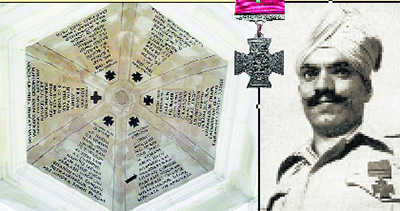His name figures next only to that of Lance Naik Lala Ram, the first recipient of Victoria Cross

Col Dilbag Dabas (Retd)
The state of Himachal has two very unique distinctions to its credit — the first Param Vir Chakra awardee of independent India Major Somnath Sharma was from the state; and the first pair from the same battalion, earning for themselves the highest gallantry award in the same war, was composed of Capt Vikram Batra (referred to as Sher Shah by the enemy in the intercepted messages of Pakistan army) and Rifleman Sanjay Kumar, both Himachalis.
And, if the state-wise list of gallantry awards is any indicator, Himachal Pradesh with a population of just about 1.5 per cent of the Indian total is way ahead than other states in demonstrating valour by its soldiers.
In the roll of honour of the Himachali bravehearts, the name of Bhandari Ram figures next only to that of Lance Naik Lala Ram, the first recipient of the Victoria Cross, nurtured by the Himachali soil.
Bhandari Ram was born on July 24, 1919, in Serva Geharwin village in the then Bilaspur state, now Bilaspur district of Himachal Pradesh. For Himachali Dogras, soldiering is not just another profession, but a calling. At 22, Bhandari enlisted in 16th Battalion of 10th Baluch Regiment with a class composition of two third of Baluchi Musalmans from North West Frontier and one third Dogra Brahmins from the present day Himachal.
During the third Arakan offensive by the allied troops in Burma campaign in World War-II, 16th Baluch under command 51 Indian Brigade was tasked to clear the route into north-western Arakan through the Mayu hills. As a prelude to the accomplishment of the task, a number of small operations and raids were carried out to soften up the Japanese defenses before launching attack by a larger force. In one such operation, for his cool courage, strong determination and utmost devotion to duty, Sepoy Bhandari Ram was awarded the Victoria Cross.
After independence, the 10th Baluch Regiment was allotted to Pakistan and Sepoy Bhandari Ram and his colleagues were absorbed in the newly raised 8th Battalion of Dogra Regiment of the Indian Army.
Sepoy Bhandari Ram, the battle hardened Dogra of World War-II fame displayed his tenacity three years later during the first India-Pakistan war in 1947-48, wherein he fought against his former Baluch colleagues in Jammu and Kashmir and did not let them succeed in their evil designs of annexing the Indian territory.
Bhandari Ram retired from service as Honorary Captain in 1969 after a distinguished military career spanning almost three decades, having participated in Burma Campaign (1944) and in three wars i.e. 1947-48 India-Pak, 1962 Sino-India, and 1965 Indo-Pak war. Hony Capt Bhandari Ram, VC, an ardent admirer of Lal Bahadur Shastri, passionately believed in the creed of the two noblest professions, namely the Jawan and the Kisan, almost in equal measure and did farming until ill-health prevented him from working in fields.
On May 19, 2002, this gallant Dogra breathed his last in his native village. His mortal remains were cremated with full military honours in the presence of many high-ranking serving and retired defence officers and a representative of the British High Commission.
(The writer is a veteran Gunner, 6 Field Regiment)
Battle account of his valour
The battle account of his valour recorded in the War Diary of his battalion and corroborated by the book ‘For Valour’ written by British historian Bryan Perrett reads: “On November 22, 1944, during an attack on a strongly held Japanese position in Mayu hills in Burma, Sepoy Bhandari Ram was with the leading section of his platoon. When the leading elements were within 50 yards of the objective, they were pinned down by accurate fire from a light machine gun, in which Bhandari got a burst of fire on his left shoulder and was also wounded in his leg. Bhandari did not give up and in full view of the enemy and under menacing fire kept crawling up to the machine gun bunker. Even the enemy’s grenade splinters and bullets did not deter him from his resolve to silence the machine gun. In spite of the grave danger he faced, he crawled up to within five yards of the bunker and lobbed a grenade killing the crew of two gunners. He then crawled back to his section and joined the successful dash on to the objective. As a true soldier, and a Dogra at that, he got his wounds dressed only after the objective was finally captured. The gallant action of Sepoy Bhandari Ram was a desperate individual effort to overcome enemy opposition at a crucial moment in the battle – a moment which nearly cost him his life”.
